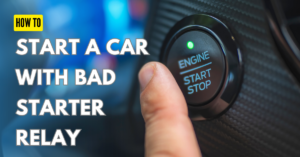A car with a low or dead battery can often be started by jumpstarting or using a bump start method, but the method varies depending on whether the vehicle has a manual or automatic transmission.
In the case of a manual transmission, you can often bump start (also known as push start or roll start) the car. However, for automatic transmissions, bump starting typically isn’t possible due to the different mechanics of the transmission system.
So, when dealing with a low or dead battery, knowing the type of transmission your car has can be crucial in determining the best way to get it started again.
What is a Low or Dead Battery ?
A low or dead battery, often referred to as a flat battery, occurs when the battery lacks sufficient charge to crank the engine. If your car battery is flat, you won’t be able to start your vehicle.
How To Know If Car Battery is Dead ?
A flat battery is often indicated by a weak or non-existent engine crank when you turn the key, along with dashboard lights flickering upon ignition and the radio or music system not working. It’s crucial to check for these signs of a dead battery before attempting to jump-start or bump-start your vehicle.
A car battery can become dead or low due to corrosion buildup. Corrosion can block the flow of electricity, resulting in no power reaching the starter. To address this issue, check the battery terminals for any signs of corrosion. If corrosion is present, cleaning the car battery terminals may resolve the problem of a dead battery preventing the car from starting.
How To Jump Start Your Car ?
Both manual and automatic transmission vehicles can be jump-started using the same method. Jump-starting a car involves using a set of jump leads or jumper cables to transfer energy from a functioning battery to a dead or flat battery.
It’s crucial to follow the correct steps when jump-starting a car to prevent damage to the electrical system. Here’s a basic guide on how to prepare for a jump-start:
- Use only a 12–volt supply to start your vehicle.
- Do not disconnect the battery of the disabled vehicle as this could damage the vehicle’s electrical system.
- Park the booster vehicle close to the hood of the disabled vehicle making sure the two vehicles do not touch. Set the parking brake on both vehicles and stay clear of the engine cooling fan and other moving parts.
- Check all battery terminals and remove any excessive corrosion before you attach the battery cables. Ensure that vent caps are tight and level.
- Turn the heater fan on in both vehicles to protect any electrical surges. Turn all other accessories off.
How To Bump Start Your Car ?
A car can be started without a booster battery through a method called bump starting (also known as push starting or roll starting). However, it’s important to note that this method cannot be applied to automatic transmission cars.
Starting a car using the bump start method involves physically moving the car to create the momentum needed to turn the engine and initiate the starting process. It’s typically used for manual transmission vehicles. The driver engages a gear (usually second or third), presses the clutch pedal, and then either pushes the car while someone else steers or rolls down a slope. When sufficient speed is reached, the driver releases the clutch pedal, engaging the engine and starting the car.
Why Jump Start or Bump Start not working ?
Jump-starting and bump-starting are indeed reliable methods to start a car with a dead battery. However, if the car won’t start after attempting these methods, there might be underlying issues that need attention. Here are some possible reasons why a car may not start:
- No cranking at all: If the car doesn’t make any noise when you turn the key (no cranking), there could be problems with faulty wiring, blown fuses, or other electrical issues, as well as sensor malfunctions.
- Cranking But Won’t Start: If the car cranks but doesn’t turn over and start, this could be indicative of problems with the fuel system. Issues with the fuel pump, fuel pump relay, or fuel pump fuse, as well as ignition problems, could be the culprits.
Conclusion
In conclusion, when your car experiences issues starting, whether due to a dead battery or other problems, knowing the right methods to jump-start or bump-start it can be a real lifesaver. However, it’s equally essential to recognize that these methods might not always work if there are underlying issues with the vehicle’s electrical or fuel systems.


